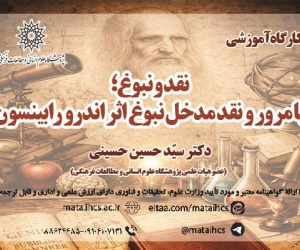گل و بلبل؛ استحاله گیاه مقدس در هنر ایران (مقاله علمی وزارت علوم)
درجه علمی: نشریه علمی (وزارت علوم)
آرشیو
چکیده
از زیباترین تقابل های عاشقانه و عارفانه نزد هنرمندان و ادیبان ایرانی، تقابل گل و بلبل است که به مثابه عاشق بر گرد معشوقی چون گل می نشیند. این تجسم نزد نگارگران صفوی قوت گرفت و در دوران زند و قاجار به اوج خود رسید. نقاشی گل و بلبل، کم کم گسترش یافت و از تک بوته ها به گلشن هایی با گل های متفاوت تبدیل شد. هدف این پژوهش، بررسی تداوم نقش و ترکیب گیاه مقدس در دوره ایران باستان تا تطور آن به ختایی و پس از آن گلشن در دوره اسلامی است. این پژوهش در پی پاسخ به این سوالات است: تطور گیاه مقدس از دوره پیش از اسلام به ختایی در دوره اسلامی و استحاله آن به گلشن چگونه است؟ چگونه می توان اعتقاد به منشأ انسانی گیاهان را در گل و بلبل تبیین نمود و کدام ویژگی های بلبل در ادبیات ایران، در تقابل گل و بلبل پرکاربردتر بوده است؟ بنابراین به بررسی اهمیت گیاه مقدس در دوره ایران باستان و استحاله ادبی آن به طوبی در اسلام پرداخته شده است تا بتوان ضمن بررسی اولین الگوهای گل و مرغ، هویت مرغ را در این تقابل تبیین نمود؛ سپس با رجوع به منابع ادبی، جایگاه بلبل را شناخته و علت کاربرد فراوان آن را کنکاش نمود. روش انجام تحقیق حاضر، توصیفی- تحلیلی است و در گردآوری منابع از روش کتابخانه ای استفاده کرده است. یافته های تحقیق نشان می دهد در بررسی پیشینه گلشن ها با سه الگو مواجه می شویم: گلشن هایی با مقطع رویش نامشخص و متراکم، گلشن هایی با مقطع رویش نامشخص و مدور (حلزونی) و الگوهایی با مقطع رویش مشخص که هر سه الگو، با اندکی تغییرات به سنن تصویری دوره های پیش از اسلام می رسند.Gol-o-Bolbol: The Transformation of the Sacred Plant in Iranian Art
One of the most beautiful romantic and mystical confrontations among Iranian artists and writers has been the confrontation between Gol-o-Bulbul (the flower and nightingale), in which Bulbul sits by the flower (beloved) like a lover. This embodiment was strengthened by the Safavid painters and reached its peak during the Zand and Qajar periods. The painting of Gol-o-Bulbul gradually expanded from bushes to “Golshan” with different flowers (Roses, Iris, Tulips, Liliums, Dahlias, Hyacinths, and Blossom). The aim of this article is to study the continuity and composition of the role of the sacred plant from ancient Iran to “Khatai” in the Islamic period and to “Golshan”. This study seeks to answer these questions: what is the evolution of the sacred plant from the pre-Islamic period, to Khatai in the Islamic period, and to its transformation into Golshan? How can the belief in the human origin of the plants be explained in flowers and birds and what are the characteristics of birds? Has it been more widely used in Iranian literature in contrast to Gol-o-Bulbul? Then, referring to literary sources, the dignity of the Bulbul was recognized and the reason for its widespread use was explored. The deployed research method is descriptive-analytical, and the data have been collected through library study. In examining the history of Golshan, three patterns are encountered: first, Golshan with an indeterminate and dense growth section; Golshan with an indeterminate and circular (spiral) growth section; and patterns with a definite growth section, all of which are traced back to visual traditions of pre-Islamic periods, despite slight differences.









